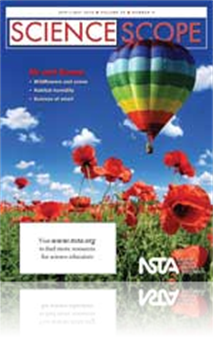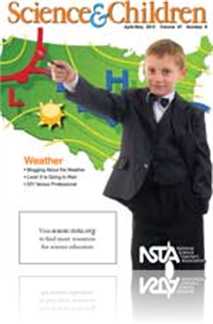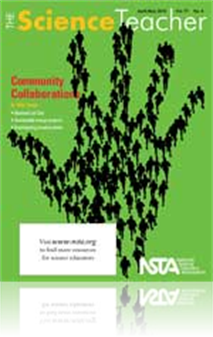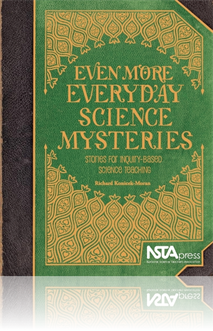All Resources
Journal Article
Science Sampler: A project-based environmental unit for teaching content through inquiry
Recent science education reform efforts for adolescents have attempted to engage students in science by using project-based instruction (Rivet and Krajcik 2008). The features of project-based learning (PBL) are consistent with the learning needs of m...
Journal Article
Over 200 science, mathematics, and technology teachers have participated in real-world industry experiences through the Industry–Education Partnership (IEP) program at the Mississippi State University. Since 2005, IEP teachers have traveled to the ...
Journal Article
Editor’s Note: Conceptual Understanding
Weather. Doesn’t that sound like an easy topic to teach and learn? Children experience it without effort and without even thinking about it. But, that’s part of the problem. We need to take every opportunity to create circumstances for students t...
Journal Article
Editor’s Corner: National Lab Day
In November 2009, President Obama helped launch National Lab Day (NLD)—an initiative that promises to become the most ambitious science–education partnership project ever in the United States. NLD is a nationwide movement to “build local commun...
Journal Article
My students have their headphones on all the time! Could they be at risk for permanent hearing loss? How loud is too loud?...
Journal Article
Methods and Strategies: Making the Climate Connection
This article presents classroom resources for teaching both weather and climate along with background resources for teachers who want to beef up their own knowledge in the subjects. In addition, the author proposes learning progressions that teachers...
Journal Article
Home Sweet Home: How to Build a Madagascar Hissing Cockroach Habitat Out of Recycled Materials
Madagascar hissing cockroaches (MHC) are amazing insects that can be an integral part of an effective science learning and teaching environment. MHCs have a fascinating social structure. They make excellent pets, teach students how to properly care f...
Journal Article
It is important to help young children make connections between events in their lives and science concepts in preschool classrooms, so introducing basic meteorology ideas offer a great opportunity to make weather connections and awaken scientific cur...
Journal Article
The Adventures of the Gray Whale: An Integrated Approach to Learning About the Long Migration
Using migration as a springboard, students can begin to understand patterns of survival and interdependence that exist within nature, as well as humankind’s role in modifying these patterns. This mini-unit involves a series of integrated activities...
Journal Article
Students for Sustainable Energy
At Montpelier High School (MHS) in Vermont, students are accustomed to making changes in their school and community. Over the last six years, MHS students have participated in the Annual Winooski River Cleanup Project, the construction of a solar-pow...
Journal Article
Career of the Month: An Interview With Tsunami Researcher Vasily Titov
When the Indian Ocean tsunami struck Sumatra in 2004, nations around the world were shocked to learn that tsunamis, though rare, are a major threat to people and property. Tsunami researchers investigate these natural disasters in an attempt to forec...
Journal Article
This monthly feature contains facts and challenges for the science explorer. ...
Journal Article
Fifth graders in Mrs. Caldwell’s class would soon experience a “change” as they made the transition from elementary to middle school. Participation in classroom inquiry investigations and schoolwide science enrichment events had already develop...
Journal Article
Tried and True: Soil is more than just dirt
This article describes a series of activities in which students investigate soil, culminating in the biomimicry of reducing landfill waste. After students learned about soil’s ecosystem structure and the function of its food web with nutrient cycli...
Journal Article
Science Sampler: Smelling the chocolate—The Perks of modeling habit of mind
Branston, a sixth-grade urban charter school student, used scientific habits of mind to explain a real event. This was due to a series of lessons that make up the “smell” unit (Krajcik et al. 2006), a six-week, project-based unit to develop a mod...
Journal Article
This monthly feature contains facts and challenges for the science explorer. ...
Journal Article
Cruising the Climate With Spreadsheets
Electronic spreadsheets and online weather databases are excellent tools for making real-world comparisons of local, national, and global climate trends. The activities described in this article incorporate these tools to help familiarize students wi...
Journal Article
Everyday Engineering: A little flash (of) light
The flashlight is a simple device that is composed of a lightbulb, usually two cells connected in series, a housing, a switch, and a reflector for the light. All flashlights essentially use these parts to complete a circuit that converts the stored c...
Journal Article
“If someone were traveling to our area for the first time during this time of year, what would you tell them to bring to wear? Why?” This question was used to engage students in a guided-inquiry unit about how climate differs from weather. In thi...
Journal Article
To engage students in a real-world issue (Bransford, Brown, and Cocking 2000) that affects their communities, the author designed an entire unit to investigate air pollution in their home state, Connecticut. The unit’s goal is to understand how the...
Journal Article
In the scientific community, the symposium is one formal structure of conversation. Scientists routinely hold symposiums to gather and talk about a common topic. To model this method of communication in the classroom, the author designed an activity ...
Journal Article
Idea Bank: The Lunar “Space Weather” Action Center
The Lunar “Space Weather” Action Center (LSWAC) provides an opportunity to use knowledge about the Sun’s stormy “weather” and understandings about the lunar environment to forecast “space weather” on the Moon and current “weather” c...
Journal Article
Science Shorts: The Reasons for the Seasons
Ask a fifth-grader why he or she believes Earth has seasons, and the answer usually involves a mistaken notion about Earth’s distance from the Sun. However, the construction of a three-dimensional model of the changing seasons using simple material...
Journal Article
Teaching Temperature With Project-Based Learning
In this project-based unit on weather, a fictional director of a Hungarian Wildlife Refuge invites fourth-grade students to determine whether the backyard of their school contained a variety of surface temperature environments that would satisfy the ...
Journal Article
Classroom Terraria: Enhancing Student Understanding of Plant-Related Gas Processes
Despite our best teaching efforts, many students hold misconceptions related to the roles plants play in gas-related processes (Amir and Tamir 1994; Hershey 1992; 2004). In an effort to remedy this problem, the author presents a series of activities ...
Journal Article
Safer Science: Failure of “Duty to Warn”
The science teacher has several legal duties of care to students. Taking the precautions noted in this column is a step in the right direction to avoid legal issues and make the science classroom and laboratory as safe as possible for students and te...
NSTA Press Book
Brain-Powered Science: Teaching and Learning With Discrepant Events
• How can a long metal needle pass through a balloon without popping it? • How can water flow at very different rates through two identical funnels? • How can a stick, placed on a table under several sheets of newspaper and extended over t...
By Thomas O’Brien
Book Chapter
This book, and particularly the stories which lie within, provide an opportunity for students to take ownership of their learning and learn science in a way that will give them a more positive attitude about science. In addition, it will serve to hel...
Book Chapter
Most students are totally unaware of the amount of sugar in bubble gum and don’t know that they are literally eating sugar in huge amounts. In this chapter, the author is concerned with finding out what happens to the weight of gum when it is chewe...
Book Chapter
What happens when seeds are soaked in water, you may find that your students cannot perceive of seeds absorbing so much water, for they may equate the seeds with how a sponge soaks up water. The story in this chapter offers students an opportunity to...
Book Chapter
Children may not be aware of what is exactly happening when they have their pulse taken by a doctor or nurse or even why it is important. The story in this chapter is aimed at helping children discover what kinds of activities change their heart rate...
Book Chapter
Students are usually aware that seed plants have adapted to overcrowding by developing mechanisms that disperse their seeds to other locations. In this chapter, the story explores one of the important characteristics of plant evolution, the wide dist...







